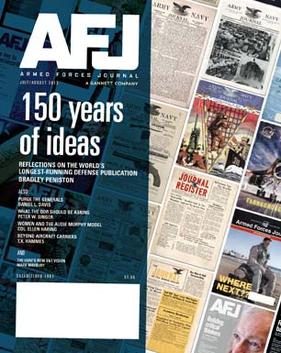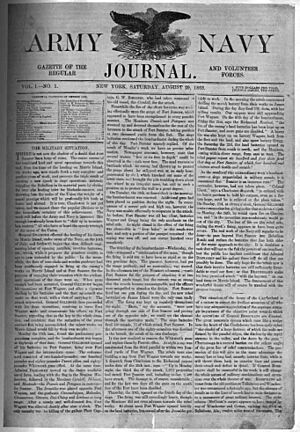Armed Forces Journal facts for kids
 |
|
| Former editors | William Conant Church Willard Church Henry J. Reilly John Callan O'Laughlin LeRoy Whitman Daniel Z. Henkin Benjamin Schemmer John Roos Thomas Donnelly Karen Walker Bradley Peniston |
|---|---|
| Categories | Journal |
| Frequency | Monthly |
| Circulation | 27,000 |
| Publisher | Michael Reinstein |
| Founder | William Conant Church, Francis Pharcellus Church |
| First issue | August 29, 1863 |
| Final issue | April 2014 |
| Company | Sightline Media Group |
| Country | United States |
| Based in | Springfield, Virginia |
| Language | English |
| Website | armedforcesjournal.com |
| ISSN | 0196-3597 |
The Armed Forces Journal (AFJ) was a special magazine for military officers in the United States. It also reached important leaders in government and businesses.
This magazine started way back in 1863 as a weekly newspaper. AFJ was published for over 150 years, changing names and owners many times. After July/August 2013, it became an online-only publication. The website was last updated on April 29, 2014.
Today, the AFJ brand is owned by Sightline Media Group. This company is part of Regent, a private investment firm. Regent bought Sightline Media Group in 2016 from Tegna.
Contents
History of the Journal
Starting in the 1800s
The magazine began as The Army and Navy Journal and Gazette of the Regular and Volunteer Forces. It was a weekly newspaper printed in New York City. Two brothers, Francis Pharcellus Church and William Conant Church, started it. William was a newspaper writer and a veteran of the American Civil War. He had helped his father with a newspaper when he was young. Later, he became a publisher and a reporter for The New York Times. In 1862, he served as a captain in the United States Volunteers for one year.
Francis Church also reported on the Civil War for The New York Times. He later wrote a very famous newspaper editorial called Yes, Virginia, there is a Santa Claus.
The first issue of the Journal came out on August 29, 1863. Its goal was to be an official newspaper for American military members. It shared news about the Civil War, which was in its third year. The paper also included official reports, promotions, and discussions about war methods. It had lots of information for both military and non-military readers. One copy cost 10 cents, and a yearly subscription was five dollars.
After the Civil War, the Army and Navy Journal helped the U.S. military become more professional. It wasn't just a social paper. It also had articles and news that helped military people feel like they were part of a shared profession.
William Church also helped start the National Rifle Association of America in 1871. He and his newspaper were important in politics for many years.
From 1894 to 1895, the newspaper's naval editor was Winston Churchill. This was not the famous British prime minister. It was a different Winston Churchill, who was a novelist. He had recently graduated from the U.S. Naval Academy.
The 1900s and Beyond
On January 19, 1903, William Church was honored at a dinner in New York. Important people like Gen. Adna Chaffee and New York mayor Seth Low spoke at the event. Even President Theodore Roosevelt sent his regrets for not being able to attend.
After William Church passed away in 1917, Willard Church became the editor for a few years.
In 1921, the magazine got a new publisher, Franklin Coe, and a new editor, Brig. Gen. Henry J. Reilly. Reilly was a West Point graduate and a World War I veteran. He also helped start the Reserve Officers Association. The newspaper's name changed to The American Army and Navy Journal, and Gazette of the Regular, National Guard and Reserve Forces.
In 1922, a yearly subscription still cost $6. The magazine had about 20,293 readers. In the same year, the paper took over National Service. This was the official publication of the Military Training Camps Association.
The newspaper and its company also published several books over the years. One of the earliest was "The Eclipse of American Sea Power" by Captain Dudley W. Knox. He was the newspaper's naval correspondent and a very important historian for the U.S. Navy.
In 1924, the newspaper's name was shortened to The Army and Navy Journal.
The O'Laughlin Years
In 1925, John Callan O'Laughlin bought the newspaper. He was a former reporter and a major in the U.S. Army during World War I. O'Laughlin was close with President Roosevelt. He even served briefly as the president's assistant secretary of state.
O'Laughlin became the editor and publisher. He changed the newspaper's name to the Army and Navy Journal; The Gazette of the Land, Sea, and Air. Five years later, he made LeRoy Whitman the editor.
In 1933, the newspaper changed its size. It went from a large broadsheet to a smaller tabloid format. Its offices were then in Washington, D.C.
O'Laughlin offered to have his newspaper give medals for the best-run camps of the Civilian Conservation Corps. Gen. Douglas MacArthur accepted the offer. He thanked O'Laughlin for his helpful attitude toward the War Department.
By 1938, when the magazine celebrated its 75th anniversary, it had a new motto: "Spokesman of the Services Since 1863".
In January 1945, Time magazine wrote about O'Laughlin and his newspaper. The Journal was seen as an unofficial but important voice for the U.S. Army and Navy. However, Time magazine said the Journal was not official or always correct.
After O'Laughlin
John Callan O'Laughlin passed away in March 1949. He left the Journal to the Gridiron Club, a club for journalists in Washington, D.C. The publication was valued at $500,000. However, running a magazine was not what the club usually did.
On May 13, 1950, the name changed to The Army, Navy, Air Force Journal.
In March 1958, the Gridiron Club sold the Journal to its long-time editor, LeRoy Whitman, and its general manager, Dorothy Cone Brown.
On January 4, 1962, the publication was sold to the Military Service Publishing Company.
In 1962, the Journal combined with The Army-Navy-Air Force Register. The Register was one of the oldest military publications, started in 1879. On March 17, the combined publication was renamed The Army-Navy-Air Force Journal & Register.
This name lasted for two years. Starting on July 8, 1964, the magazine was renamed The Journal of the Armed Forces.
In January 1965, LeRoy Whitman stepped down after 35 years as editor. Daniel Z. Henkin took over. Henkin left after nine months to work for the Pentagon's press office.
From 1963 to 1967, the publisher was James A. Donovan, a retired Marine Corps colonel.
The Schemmer Era
By the late 1960s, the newspaper was mostly known for social news about military officers. This changed in 1968 when Benjamin F. Schemmer bought it. Schemmer was a West Point graduate and a former infantry officer. He had also worked for Boeing and the Pentagon. On July 6, 1968, Schemmer renamed the publication Armed Forces Journal and made it a weekly magazine. It started focusing on deep analysis of defense issues. Its new subhead was "Defense Weekly." In August 1971, it became a monthly magazine. In February 1974, Schemmer added a word to the title, calling it Armed Forces Journal International.
LuAnne K. Levens, Schemmer's second wife, became the publisher in 1977.
A well-known defense expert, Anthony Cordesman, was AFJ's international editor until about April 1984.
In March 1988, Schemmer and Levens sold AFJI to Pergamon-Brassey's Defense Publishers. This was a U.S. part of Britain's Maxwell Communications. Newspapers reported the magazine had about 42,500 to 45,000 readers at that time. The publication covered international defense, weapons, and military issues in government. Schemmer stayed on as editor. He said they sold because Maxwell offered "enormous possibilities for international expansion."
Schemmer resigned in 1992 due to health reasons.
John Roos, a retired major from the U.S. Army, became the next editor.
In 1993, Donald Fruehling and his wife Gudrun bought the magazine. Donald Fruehling had managed the U.S. division of Maxwell Communications when it bought AFJI. Maxwell Communications had gone bankrupt.
The 2000s
The Gannett Years
In September 2002, Army Times Publishing Company, a part of Gannett, bought Armed Forces Journal International Publishing Co. An Associated Press report said AFJ gave military officers analysis and ideas on new technology and strategies.
In November 2005, Thomas Donnelly became editor.
Eleven months later, Karen Walker, who was the managing editor, replaced Donnelly. In April 2007, AFJ published "A Failure in Generalship" by Army Col. Paul Yingling. The Washington Post called it a "blistering attack on U.S. generals." The article argued that U.S. generals needed to change. It said they failed to see the insurgency in Iraq after the invasion. It also said they were slow to admit the insurgency began in 2004. The article got national media attention and was widely used in military and academic writings.
In 2011, Bradley Peniston became editor. The next year, the publication was named one of the top-10 magazines in its category. In February 2012, it published "Truth, Lies, and Afghanistan: How Military Leaders Have Let Us Down” by Army Lt. Col. Daniel L. Davis. This was one of the first public criticisms of the War in Afghanistan by a serving military officer. The article received praise from U.S. lawmakers. It also won Davis the 2012 Ridenhour Prize for Truth-Telling. It was covered by major news outlets like New York Times and NPR.
In 2013, Armed Forces Journal celebrated its 150th birthday. It also announced it would stop printing and become an online-only magazine.
AFJ last published on April 29, 2014. The website disappeared in mid-2015 but was brought back in January 2016, though it was not updated.
After Gannett
In 2015, Gannett separated AFJ and other publications into a new company called Tegna. In March 2016, Tegna sold the renamed Sightline Media Group to Regent. Regent is a private investment firm based in Los Angeles, controlled by investor Michael Reinstein.


